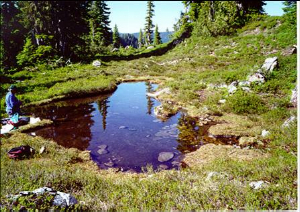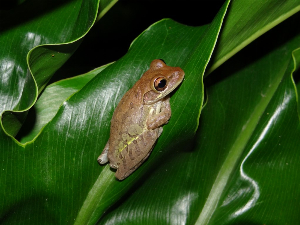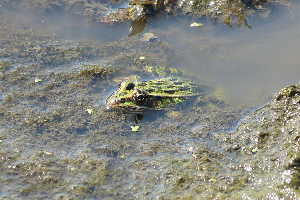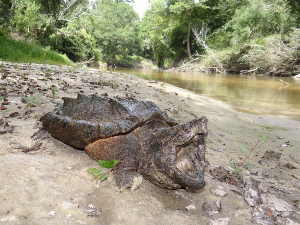Search ARMI Database
Search term(s)
Contribution Number
Search Results
73 record(s) found.
Data Release Time to detection data for Point Reyes pond-breeding amphibians, 2017
Authors: Brian J Halstead; Patrick M Kleeman; Jonathan P Rose
Date: 2018-12-14 | Outlet: USGS - Science Base
Occupancy models provide a reliable method of estimating species distributions while accounting for imperfect detectability. The cost of accounting for false absences is that detection and nondetection surveys typically require repeated visits to a site or multiple-observer techniques. More efficient methods of collecting data to estimate detection probabilities would allow additional sites to be surveyed for the same amount of effort, which would support more precise estimation of covariate effects to improve inference about underlying ecological processes. Time-to-detection surveys allow the estimation of detection probability based on a single site visit by one observer, and therefore might be an efficient technique for herpetological occupancy studies. We evaluated the use of time-to-detection surveys to estimate the occupancy of pond-breeding amphibians at Point Reyes National Seashore, California, USA, including variables that affected detection rates and the probability of occurrence. We found that detection times were short enough, and occupancy was high enough, to reliably estimate the probability of occurrence of three pond-breeding amphibians at Point Reyes National Seashore, and that survey and site conditions had species-specific effects on detection rates. In particular, pond characteristics affected detection times of all commonly detected species. Probability of occurrence of Sierran Treefrogs (Hyliola sierra) and Rough-skinned Newts (Taricha granulosa) was negatively related to the detection of fish and pond area. Time-to-detection surveys can provide an efficient method for estimating detection probabilities and accounting for false absences in occupancy studies of reptiles and amphibians.
Data Release Shasta Salamanders Surveys for the Shasta-Trinity National Forest (ver. 2.0, July 2020)
Authors: Brian J Halstead; Patrick M Kleeman
Date: 2019-11-26 | Outlet: USGS - Science Base
The Shasta salamander (Hydromantes shastae) has been petitioned for listing under the Endangered Species Act. The greatest threat to the species is likely habitat loss that will be caused by the increase in elevation of Shasta Lake that will occur with proposed increases in the height of Shasta Dam to increase water storage capacity and maintain cold water for Chinook salmon (Oncorhynchus tshawytscha). Another potential threat is the fungus Batrachochytrium salamandrivorans, which has not yet been detected in North America but is lethal to related salamanders (Hydromantes strinatii) in Europe (Martel et al. 2014). In addition to these threats, recent genetic evidence suggests that the species as originally petitioned consists of three distinct species: H. shastae, H. samweli, and H. wintu (Bingham et al. 2018). Herein, we treat the species complex as a single entity because of difficulty distinguishing among the different species in the field. Recent work has increased knowledge about the habitat types within which Shasta salamanders can be found to include volcanic rock outcrops and areas of mature forest with scattered rocks, but no outcrops (Nauman and Olson 2004). To our knowledge, however, surveys to date have not accounted for the possibility of false absences, though Nauman and Olson (2004) used reference sites to ensure that Shasta salamanders were available on the surface to be detected. Systematic surveys that quantify and account for detection probabilities are needed to distinguish between true and false absences and their results would contribute information about habitat suitability and the distribution of the species. This information is vital to estimate what portion of the species complex would be lost to inundation when the elevation of Shasta Lake is raised and to identify potential refugia or recipient sites for translocations.
Data Release Site and Survey Data for Amphibian Surveys in Yosemite National Park, 2018
Authors: Brian J Halstead; Patrick M Kleeman
Date: 2020-11-19 | Outlet: USGS - Science Base
These data represent occupancy surveys conducted in long-term monitoring sites in Yosemite National Park in 2018 for three anurans, the Yosemite Toad (Anaxyrus canorus), the Sierran Treefrog (Pseudacris sierra), and the Sierra Nevada Yellow-legged Frog (Rana sierrae). The data include independent double-observer surveys and time-to-detection data to calculate detection probabilities and account for false negatives, or the failure to detect a species at a site where it occurs.
Data Release Site and Survey Data for Dixie Valley Toads in Churchill County, Nevada, 2019
Authors: Brian J Halstead; Patrick M Kleeman
Date: 2020-11-19 | Outlet: USGS - Science Base
These data include site- and survey-specific information for occupancy surveys of Dixie Valley Toads (Anaxyrus williamsi) collected in the Dixie Valley, Churchill County, Nevada, in May 2019. The data include both multiple surveys of the same sites and time-to-detection information to quantify detection probabilities and account for imperfect detection in assessments of Dixie Valley Toad occupancy.
Data Release Data realease for manuscript: A statistical forecasting approach to metapopulation viability analysis
Authors: P E Howell; Blake R Hossack; Erin Muths; Brent H Sigafus; A Chenevert-Steffler; Richard Chandler
Date: 2020 | Outlet: Ecological Applications 2020: e02038
Data release and code for Ecological Applications paper: A statistical forecasting approach to metapopulation viability analysis
Data Release Data from time-constrained visual encounter surveys and acoustic surveys in the Atchafalaya Basin conducted from 2008 through 2016
Authors: Brad M Glorioso; Hardin J Waddle
Date: 2020-08-13
This dataset contains data from time-constrained visual encounter surveys conducted in the Atchafalaya River Basin in south central Louisiana from February 2008 through July 2016. In addition, it contains vocalization data collected concurrently with the visual encounter surveys and data on presence of tadpoles and larvae. All participants in surveys are included in the dataset. Information for each site, each sample, and each observation is included.
Data Release North Coast and Cascades Network consolidated amphibian database (1984-2005)
Authors: Stephanie K Galvan; Michael J Adams; B Samora; S E Stonum; P J Happe; R S Glesne; A Rawhouser
Date: 2020-10-20
This data set is an amalgamation of twenty-nine original data sets, which represent amphibian surveys in the seven national parks comprising the North Coast and Cascades Network (NCCN) of the National Park Service. The data were collected from 1984-2005, and include the localities of 19 species of amphibians at various life stages, 18 native to the Pacific Northwest and one invasive species
Data Release Data from visual encounter and acoustic monitoring surveys targeting amphibians and reptiles in Big Thicket National Preserve in southeast Texas from August 2010 to September 2018
Authors: Brad M Glorioso; Hardin J Waddle
Date: 2020-08-07
This dataset contains data from visual encounter and acoustic surveys in Big Thicket National Preserve in Texas from August 2010 to September 2018. This dataset also includes salinity measurements from nine salinity loggers deployed in the study area.
Data Release Data from a 2015 trapping survey targeting the Gulf Coast Waterdog, Necturus beyeri, in Saint Tammany Parish, Louisiana
Authors: Brad M Glorioso; Hardin J Waddle
Date: 2020-06-05
This dataset provides the data associated with a 2015 project to examine factors affecting the occupancy of Gulf Coast Waterdogs along Bayou Lacombe, Saint Tammany Parish, Louisiana. Data include site locations and distance from headwaters, water data (pH, turbidity, salinity, and depth), and capture data from trap checks. For Necturus beyeri captures, the datatset provides the sex of captures and length and mass measurements. The dataset states whether eggs were visible in females, whether each animal was swabbed for disease and whether tissue was clipped for genetics.
Data Release Seasonal median daily water depths for study wetlands in the St. Croix National Scenic Riverway, the North Temperate Lakes Long-term Research area, and the Upper Mississippi River study area from 2013-2018
Authors: Walt J Sadinski; Mark F Roth
Date: 2020-05-20 | Outlet: U.S. Geological Survey data release, https://doi.org/10.5066/P9H4VLEM
To relate water levels in our study wetlands to temperature, precipitation, wetland water depth, and amphibian calling activity, we installed one pressure logger in the deepest spot we could find in each wetland. Soon after thawing conditions allowed, we drove a plastic pipe (anchor pipe) into the sediments at the deepest location and secured another pipe to it that contained one pressure logger (Onset Computer Corporation Model U20-001-04 [Bourne, MA, USA]) suspended approximately 2.5 cm above the sediments. We installed additional individual pressure loggers in the upper part of the logger pipes (in air) at select locations to measure barometric pressure for calibrating the submerged loggers’ readings. We measured pressure once per hour and used software supplied by the logger manufacturers to upload and convert data to depth at the end of each season.
Data Release Oregon spotted frog (Rana pretiosa) monitoring data for metademographic analysis 2010-2018, Oregon: U.S. Geological Survey Data Release
Authors: Jennifer C Rowe; Adam Duarte; James T Peterson; Christopher A Pearl; Brome McCreary; Stephanie K Galvan; Michael J Adams
Date: 2020-05-05 | Outlet: ScienceBase
This dataset contains information from surveys conducted 2010-2018 by USGS as part of a long-term Oregon spotted frog monitoring effort in the central Oregon range. Data consist of site, survey, habitat, and species detection covariates, as well as inter-site distance measurements.
Data Release Body measurements of the exotic invasive Cuban treefrog (Osteopilus septentrionalis) in Louisiana
Authors: Brad M Glorioso; Hardin J Waddle
Date: 2018-01-19
This dataset provides location and standard measurements of captured Cuban Treefrogs from the Audubon Park and Zoo area of New Orleans, Louisiana.
Data Release Bd and Bsal Prevalence in Gulf Coast waterdogs captured from St. Tammany Parish, Louisiana, in 2015
Authors: Brad M Glorioso; Hardin J Waddle
Date: 2017-06-22
The dataset includes information on all 76 Gulf Coast waterdogs captured including sex and size information along with the results of the tests for the two fungal pathogens.
Data Release Data from a national survey for the amphibian chytrid fungus Batrachochytrium salamandrivorans
Authors: Hardin J Waddle; Daniel A Grear; Brad M Glorioso; Adam R Backlin; William J Barichivich; Adrianne B Brand; Daniel L Calhoun; Jill Fleming; A Dietrich; Patrick M Kleeman; M A Cruz
Date: 2019-05-22
This dataset provides the results of a national survey of the conterminous U.S. for the salamander chytrid fungus Batrachochytrium salamandrivorans (Bsal) conducted by the U.S. Geological Survey Amphibian Research and Monitoring Initiative from May 2014 to August 2017. Sites were sampled by capturing amphibians by hand or by traps or nets that were then swabbed individually using methods that prevent sample contamination. All swabs were then analyzed using a real-time TaqMan PCR for detection of B. salamandrivorans on the extracted DNA. The data consist of locality information and data on the individual sampled, as well as the result of the test for B. salamandrivorans. No cases of B. salamandrivorans were detected in this study.
Data Release Amphibian Occupancy and Effects of Habitat Use on Pesticide Exposure in Iowa Wetlands
Authors: J E Swanson,; Erin Muths; Clay L Pierce; M Vandever; Kelly L Smalling
Date: 2018-03-09 | Outlet: US Geological Survey Data Release
Amphibians living in agricultural areas encounter many challenges. Two factors affecting individuals in these landscapes are habitat loss and pesticides. This thesis focuses on amphibians using agricultural wetlands in Iowa, where row crops such as corn and soybeans dominate the landscape. The goal of of the first study was to determine the influences of site characteristics on amphibian presence and success. Occupancy analysis was used to estimate proportion of area occupied by four species as a function of eight covariates hypothesized to affect occupancy: fish abundance, salamander abundance, invertebrate density, vegetative cover, wetland area, water atrazine concentration, surrounding crop land use, and overall wetland health score. We surveyed 27 wetlands in 2015 and 2016. Occupancy analysis results indicate almost all covariates were supported in our model sets although their estimated effects were weak. Direction of predicted effects of covariates on amphibians varied by species and life stage. Results show that wetland site occupancy for species in our study ranged from https://0.23 to https://0.95. Although we did not find strong evidence that the environmental factors we measured influenced amphibian occupancy, we provide insight on amphibian use of a modified agricultural landscape. The goal of the second study was to understand where and when frogs are most susceptible to pesticide exposure and how that exposure relates to accumulation. We hypothesized habitat use would influence a frog’s exposure to pesticides. We radio tracked 72 Northern Leopard Frogs (Lithobates pipiens) in agricultural wetlands and assessed their survival. We used Passive Sampling Devices (PSDs) to test for differences in pesticide exposure among grassland, wetland, and agricultural habitats. We found that pesticide concentration analyzed from PSDs varied among habitat types (P < 0.01) with concentration greatest in agricultural habitats. Amphibians frequently used wetland habitats early in our study, and transitioned into grassland habitats later in the summer, using agricultural fields rarely. Number and concentration of pesticides were greatest in tissues collected in May, but few pesticides were detected in individuals captured in August (P < https://0.01 and P < https://0.01, respectively). Our results indicate risk of pesticide accumulation is highest in aquatic habitats earlier in the year.
Data Release Data from a turtle trapping effort at a release site of head-started alligator snapping turtles, Macrochelys temminckii, in southwest Louisiana in 2018
Authors: Brad M Glorioso; Charles D Battaglia; J Streeter; Hardin J Waddle
Date: 2020-05-01
This dataset contains initial data from head-started alligator snapping turtles released by Louisiana Department of Wildlife and Fisheries (LDWF) from November 2015 to October 2016. In addition, it contains data from a five-day trapping effort at each of seven release sites by the United States Geological Survey (USGS) from late June to early October 2018. Trapping was completed using hoop nets of three sizes. We recaptured eight head-started alligator snapping turtles as well as four individuals native to the creek.
Data Release Surface water data for isolated stock ponds in southern Arizona, USA and northern Sonora, Mexico: U.S. Geological Survey data release
Authors: Christopher J Jarchow; Brent H Sigafus
Date: 2019
Jarchow, C.J., and Sigafus, B.H., 2019, Surface water data for isolated stock ponds in southern Arizona, USA and northern Sonora, Mexico: U.S. Geological Survey data release, https://doi.org/10.5066/P95ZFPT1.
Data Release Water quality data from the Goose Lake Study Site Eastern Montana 1989-2018: U.S. Geological Survey data release.
Authors: Todd Preston
Date: 2019
Data release for water quality information from the Goose Lake Study Site, northeastern Montana.
Data Release Chloride in water, metals in sediment and amphibian tissues and amphibian capture information from wetlands in the Williston Basin of Montana and North Dakota, 2015-2017: U.S. Geological Survey data release
Authors: Kelly L Smalling; Blake R Hossack; R K Honeycutt; Chauncey W Anderson; I M Cozzarelli,
Date: 2018
Data release for data collected from Prairie Pothole wetlands.
Data Release Data release for manuscript IP-083575, Robert Fire Montana Tailed Frog Data_2001-2015
Authors: Blake R Hossack
Date: 2015
Data release for manuscript summarizing responses of Rocky Mountain Tailed Frogs to the 2003 Robert Fire in Glacier National Park.






